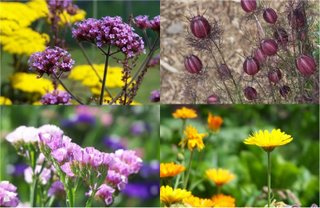
Ryton Flowers #1: The Organic Allotment
I'm lucky enough to work in one of the best gardens in Britain (I'm biased already!) We have a civilised hour for lunch, which gives me plenty of time to eat (an organic!) lunch then go out with a camera or sketchbook and wait for the flowers to stop waving about in the wind. It would be out of place for me to aim to describe the whole gardens, as we've an excellent website (www.gardenorganic.org.uk/) already which does that job. But I'll post some of my photos from time to time, and perhaps they'll encourage you all to visit and see it for real!
The Organic Allotment is one of over 15 gardens, and has lots of ideas for people wanting to grow their own food. It has four plots which are rotated so that no crop is grown in the same place more than once in four years. This helps to keep pests and diseases down, and also is used to control the level of fertility in the soil for different requirements of different crops.
A big feature of the garden is the use of 'companion' planting using plants which some might consider merely ornamental. Here there is Painted Sage (Salvia viridis) in the foreground to attract pollinators for the beans. In the background are tomatoes and sweetcorn and aubergines, being grown as a 'catch crop' after potatoes, surrounded by marigolds (Calendula) to attract hoverflies to eat aphids.

In a different plot brassicas are being grown. Next year they will move into the plot where the beans are now. Beans and other leguminous plants can 'fix' nitrogen from the air into the soil, making it suitable for 'hungry' crops like cabbages and sprouts. The strong taste of these vegetables is partly the reason for their requirement for nitrogen: they turn it into chemicals which can repel pests. But not all, which is why there is a net to keep out Large White butterflies, and Echium vulgare (Viper's Bugloss) almost swamping the cabbages, to put off Cabbage Root Fly and attract hoverflies. (How this repells Cabbage Root Fly is really interesting but it'll take too long this time!)

It seems fortuitous that the blues of the cabbages and that of the Bugloss go so well together!
The composite picture at the top includes (clockwise from top left) Verbena bonariensis with Achillea in the background; sputnik-like Nigella seed-heads; Calendula, and Statice, an 'everlasting' flower which is also very attractive to pollinators such as butterflies.


0 Comments:
Post a Comment
<< Home